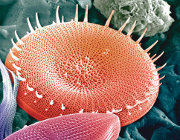Home :: List of Publicly Available Datasets :: Alexandrium monilatum CCMP3105
Alexandrium monilatum CCMP3105
Downloads:
| Principle Investigator(s) | Sonya Dyhrman, Andrew Juhl |
|---|---|
| External sample ID | Am, replete, future CO2 |
| NCGR Sample ID | MMETSP0097 |
| Sample accession number | CAM_SMPL_002389 |
| Assembly accession number | CAM_ASM_000207 |
| Combined Assembly Name | Alexandrium-monilatum-CCMP3105 |
| Genus | Alexandrium |
| Species | monilatum |
| Strain | CCMP3105 |
| Clonal | Yes |
| Axenic | No |
| Prelim. NCBI Taxon ID | 311494 |
| 18S rRNA | |
| Importance of organism and transcriptomes | We are nominating Alexandrium monilatum as a representative toxic dinoflagellate among 6 marine phytoplankton species (from 4 Phyla) that together form a comparative study of how physio/chemical parameters, including future ocean scenarios, affect the physiological ecology of key bloom-forming microeukaryote species (please see additional nominations from PIs Dyhrman and Juhl). Each of the 6 species will be grown under identical physiological stresses or treatments (see below), allowing direct comparisons between major phytoplankton groups to the same suite of experimental treatments, and between treatments within each species, while maximizing transcriptome coverage over differentially regulated genes. A. monilatum is less well studied from a molecular perspective than some of the other Alexandrium species, and because of its basal position within the genus (Rogers et al. 2006), provides an important comparison to the more well-known members of the genus. A. monilatum is ecologically distinct from many other Alexandrium species because it prefers warm water (Juhl 2005) and does not produce saxitoxins, although it does produce other toxins that can cause massive fish kills and shellfish mortality (May et al. 2010). The strain JR08 was isolated from a dense bloom sample collected in Mississippi Sound USA in Sept 2000 (Juhl 2005). It forms long chains, swims vigorously, and is strongly bioluminescent. Bioluminescence and cell division in this species are tightly coupled to the day/night cycle suggesting dramatic differences in gene expression between day and night samples. |
| Additional citations and references | |
| Environmental Data | |
| Experimental Data | |
| Date of experiment | 10-JAN-12 |
| Growth medium | L1 |
| Modifications to growth medium | 16N:1P |
| Temperature (ºC) | 24 |
| Salinty (psu) | 32 |
| pH | 8.3 |
| Light (µmol photons / m2 / sec) | 100 |
| Day portion of day:night cycle in hours | 14 |
| Night portion of day:night cycle in hours | 10 |
| Nitrate (μmol/L) | 576 |
| Phosphate (μmol/L) | 36 |
| Trace elements (total) (nmol/L) | 1000 |
| CO2 (ppm) | 800 |
| Pressure (atm) | 1 |
| Investigation type | Eukaryotes |








